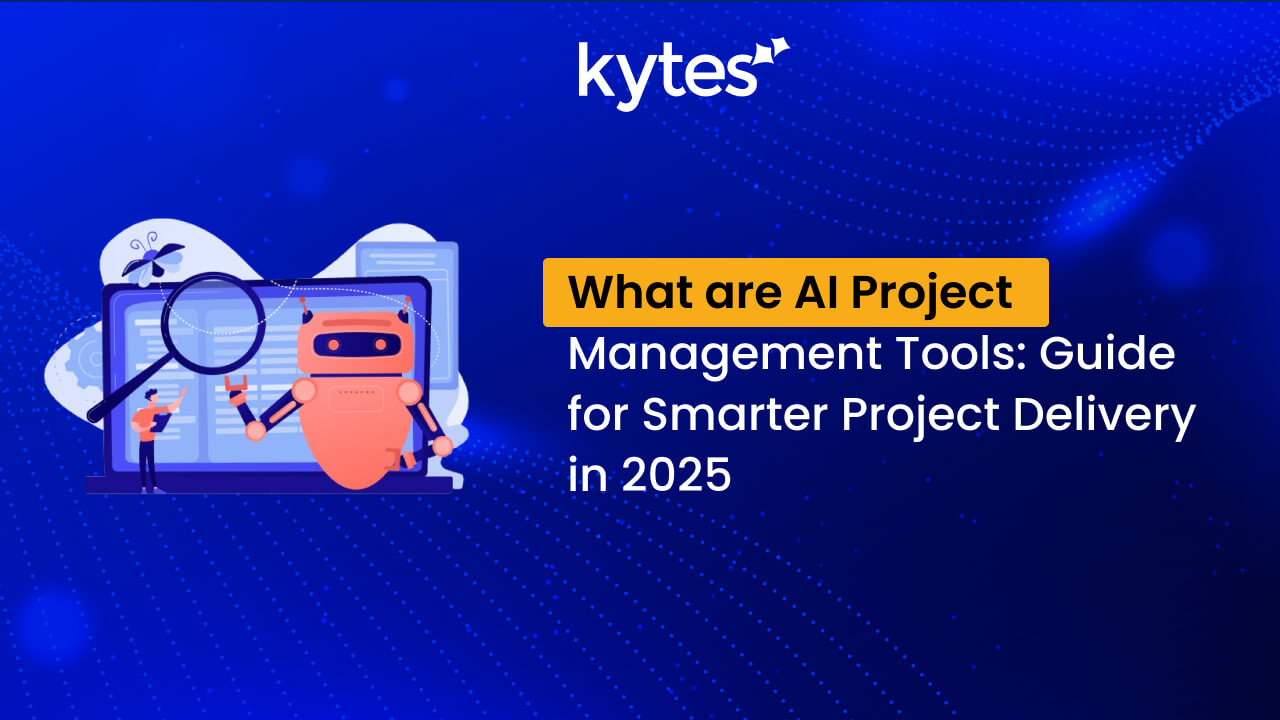What’s covered in this blog:
- A clear breakdown of what AI project management tools are—and how they work
- Real-world examples of predictive analytics, NLP, risk detection, and more
- Key considerations for evaluating AI project management tools in 2025
- Practical steps to begin your AI adoption journey
- A look at how Kytes PSA + PPM brings AI into strategic execution
Project management has always been about managing people, resources, timelines, and scope. But in today’s fast-changing business environment, legacy tools and manual processes often fall short. Deadlines get missed, resources are under- or over-utilized, and project information remains locked in spreadsheets and silos.
That’s when AI enters the picture.
AI project management tools are designed to reduce the burden of manual coordination and provide real-time assistance in planning, tracking, and decision-making. From assigning the right resources and forecasting project risks to creating executive-ready reports, AI enables teams to work smarter, not harder.
In this blog, we’ll explore what AI project management tools really are, why they’re gaining traction across industries, how to evaluate the top AI tools for project management in 2025, and how they can fit into your existing project infrastructure. If you’re a PMO or a CXO considering digital transformation, this guide will help inform your decision.
The Reality of Modern Project Management
Managing projects today is more complex than ever. Teams are remote, project requirements change rapidly, compliance regulations vary by geography, and customers expect faster delivery without compromising quality.
Even with advancements in tools, most teams still rely on disconnected systems—Gantt charts in one platform, time tracking in another, financials in spreadsheets, and risk logs managed via email. This fragmentation leads to missed dependencies, slower decision-making, and last-minute firefighting.
The culprit? Most conventional tools weren’t built for the pace and scale of today’s enterprise projects. They were designed to track tasks, not drive results.
Project managers are increasingly turning to solutions that shift them from reactive to proactive—systems capable of connecting delivery, finance, risk, and people, while providing insights without constant manual oversight.
AI is driving this shift, bringing intelligence into day-to-day project workflows and enabling organizations to stay ahead of risks, optimize resource utilization, and make data-driven decisions rather than relying on guesswork.
What are AI Project Management Tools?
AI project management tools are platforms that use artificial intelligence to aid and enhance the planning, tracking, and execution of projects. Unlike conventional tools—where users must manually update information, analyze it, and interpret the results—AI-powered systems automate repetitive tasks and provide users with real-time feedback.
Here’s what they typically include:
1. Predictive Analytics
AI analyzes historical project data to forecast potential delays, budget overruns, or resource shortages before they occur. It uses past trends, dependencies, and effort estimations to flag risks early in the cycle.
Example: If AI detects that testing phases for similar past projects typically overrun by 20%, it will alert the project manager during the planning stage and recommend extending the QA timeline or adding more testers.
2. Natural Language Processing (NLP)
NLP allows AI to understand and extract insights from unstructured data such as meeting transcripts, chat logs, or documents. It can summarize long conversations, highlight action items, and even generate minutes of meetings automatically.
Example: After a virtual project sync, AI transcribes the discussion, identifies tasks like “update risk log” or “send revised SOW,” assigns them to relevant owners, and adds them to the project tracker—without the need for manual notes.
3. Smart Scheduling and Automatic Assignment
AI optimizes schedules by evaluating workloads, availability, skills, and project priorities. It assigns the right person to the right task and adjusts timelines dynamically.
Example: If a senior UI/UX designer is available next week and has relevant past experience, AI recommends assigning them to a new design task. It also considers their leave schedule and adjusts dependent task timelines accordingly.
4. Risk Warning and Anomaly Detection
AI continuously monitors effort logs, delivery pace, and quality indicators to detect anomalies—such as scope creep or mismatches between planned and actual work.
Example: If a task estimated to take two days is now in its fifth day with no updates, AI flags the delay and notifies the PM. It may also suggest reallocating resources or triggering a risk review.
5. AI Assistants
These are chat-based or voice-enabled digital co-pilots that support daily PM activities—such as reporting, reminders, and stakeholder communication.
Example: You can ask, “Show me this week’s delayed milestones and resource utilization,” and the assistant responds with a dashboard view or downloadable report—saving hours in manual reporting preparation.
These applications do not eliminate project managers. Rather, they expand their capacity to plan and adjust, allowing more time for strategic tasks. For example, instead of preparing status reports manually, a project lead can rely on AI-generated summaries that are precise and current.
Finally, AI project management software brings speed, scale, and intelligence into project operations. Combined with clean, structured data and integrated systems, it becomes a force multiplier for delivery excellence.
Top 5 Benefits of AI in Project Management
AI is no longer a trend. It’s becoming necessary to remain competitive and resilient in project delivery. Below are five important benefits that PMOs and CXOs should look into:
1. Informed Decision-Making That Is Quicker
AI provides timely insights without the need to sift through various dashboards or files. Whether it’s predicting effort slippage or detecting idle resources, decisions become faster and better informed.
2. Predictive Risk Management
AI detects risks in advance—such as budget overspends, lagging milestones, or team capacity shortages. Instead of responding to issues, teams can act proactively on AI-generated risk warnings.
3. Smarter Resource Allocation
By examining workload, availability, and skill sets, AI can suggest optimal staffing plans. This leads to improved utilization and reduced bench time, particularly for multi-location teams.
4. Workflow Automation
Tasks such as timesheet reminders, meeting follow-ups, or report generation can be automated by AI, freeing teams to focus on higher-value activities.
5. Reliable Reporting and Compliance
AI ensures that financial and project reports are generated using standardized logic, enhancing compliance and reducing manual errors.
At Kytes, we’ve seen how these benefits multiply when AI is embedded into end-to-end project systems. It doesn’t just improve individual projects—it elevates the performance of the entire portfolio.
AI Project Management Tools Comparison 2025: What to Look For
Selecting the ideal AI project management tool can be challenging with so many options to choose from. While all tools provide some level of automation, the true differentiators lie in the depth of capability and alignment with your business requirements.
Following are some points to pay attention to:
- AI Maturity: Seek tools that offer more than surface-level automation. Do they predict potential risks, process unstructured data, and provide personalized recommendations?
- Integration Capabilities: Ensure smooth integration with your ERP, CRM, HRMS, and collaboration software so AI can access the right data.
- Security and Compliance: Confirm that the platform adheres to industry standards, especially if you’re in regulated sectors.
- User Experience: AI intelligence means little if users don’t engage with it. Assess how user-friendly the interface is and whether AI capabilities are seamlessly embedded into workflows.
- Industry Fit: General-purpose tools often lack critical nuances. Choose platforms that offer domain-specific templates, configurations, and compliance workflows.
Kytes AI-enabled PSA + PPM software is purpose-built for industries such as IT, ITES, Pharma NPD, CROs and CDMOs, GCCs, and EPCs—where compliance, utilization, and delivery timelines are most critical. From intelligent estimates to AI-generated project summaries, we’ve infused intelligence throughout the lifecycle so teams can focus on outcomes, not administration.
If you’re benchmarking solutions in 2025, consider more than just task automation. Evaluate how AI is truly delivering strategic value at the project, portfolio, and performance level
Best AI Tools for Project Management
Instead of evaluating individual software products, it’s more insightful to understand how various types of AI capabilities appear in project management tools. These applications illustrate the potential value that AI can contribute across functions:
- Automated Work Breakdown Structures (WBS): Some tools can automatically create a WBS from high-level project descriptions, eliminating hours of manual planning.
- Meeting Intelligence: NLP-powered tools can record meeting conversations, identify key action items, and automatically create follow-up tasks.
- Predictive Budget Forecasting: AI can predict cost overruns or under-spent budgets early in the project lifecycle, allowing finance teams to make timely adjustments.
- Risk Heatmaps: Real-time risk profiling can visually highlight where delays or failures are likely to occur, based on historical project trends.
- Resource Skills Matching: Advanced software compares skills, availability, and prior performance to recommend an optimal-fit team for a new project.
Kytes AI-enabled PSA + PPM introduces AI at both operational and strategic levels. This empowers teams not only with automation but also with foresight into project portfolios, budgets, resources, and compliance. Beyond efficiency, it enables control, visibility, and confidence in execution.
Implementing AI in project management doesn’t require a radical transformation. It begins with small, thoughtful steps built on a solid foundation.
A Phased Plan for Getting Started:
Step 1: Audit Your Existing Tools and Workflows
Identify bottlenecks, duplicated efforts, or information gaps where AI can make an immediate impact.
Step 2: Define a Small Pilot
Select a project or team to pilot-test AI capabilities. This allows you to test assumptions and measure results.
Step 3: Ensure Your Data Is Clean and Organized
AI applications are only as good as the data they use. Standardize naming conventions, refresh task templates, and integrate systems wherever possible.
Step 4: Train Your Team
Equip project managers and team leads to understand AI recommendations, work with AI assistants, and trust the technology.
Step 5: Scale Incrementally
Once early wins have been validated, roll out AI capabilities to additional teams and projects.
If you’re just starting your AI journey, we at Kytes can help you build the right foundations. Our PSA + PPM platform scales with your organization, providing intelligent automation and project intelligence at your pace of change.
AI adoption is as much about readiness as it is about technology. With the right system and mindset, project leaders can unlock transformative value.
The Future of AI in Project Management
As AI technology advances, project management will become increasingly smarter, context-aware, and autonomous.
We are already seeing early indicators of:
- Conversational AI interfaces that allow you to direct projects using simple natural-language instructions.
- Autonomous reporting where AI produces client reports, board presentations, and executive summaries automatically.
- Integrated portfolio-level intelligence that not only shows how projects are performing but also recommends where to reallocate budgets, resources, or timelines.
- Cross-disciplinary insights where AI aligns data from sales, delivery, finance, and HR to provide a single, unified view of project health.
At Kytes, we believe the future isn’t about replacing project managers—it’s about equipping them with a strategic advantage. The project manager’s role will evolve from coordination to orchestration, with AI serving as a co-pilot, not just a tool.
Firms that plan ahead—with the right systems, a strong data culture, and organizational readiness—will be better positioned to lead with agility, accuracy, and vision.
Conclusion
AI project management solutions aren’t a fad—they’re becoming a foundational element for how modern organizations deliver work at scale. From real-time visibility to predictive insights and automation, these tools help teams stay ahead in an environment that is constantly in motion.
The key is choosing a platform that fits your business context and delivers more than surface-level AI.
Kytes AI-enabled PSA + PPM software is purpose-built to help enterprises move from reactive execution to intelligent orchestration. If you’re ready to explore how AI can elevate your project delivery, portfolio health, and resource performance—we’re here to help.
Discover Kytes PSA + PPM to see how we turn AI into action for teams like yours.





